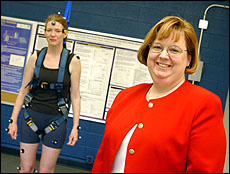Archives
Taking physical therapy to a new level
Faculty member Diane Wrisley uses new lab to study how brain controls balance
By IRENE LIGUORI
Reporter Contributor
"Would you like to see the lab?" asks Diane M. Wrisley, newest member of the Department of Rehabilitation Science.
Wrisley issues this friendly invitation with a twinkle in her eye and the air of a proud new parent—and for good reason.

Marilee Stephens is wired up in the
"reflective marker system" to have her "joint
segments" recorded on a computer screen in Diane Wrisley’s lab
in Kimball Tower. The lab will help researchers better understand how
the brain in healthy subjects processes sensory information compared
with how that occurs in people with pathologies.
PHOTO: NANCY J.
PARISI
UB created her spanking new laboratory in an effort to lure her to the faculty of the School of Public Health and Health Professions. She had been working at the Neurological Sciences Institute at Oregon Health and Science University, where she was a postdoctoral fellow.
In fact, UB wooed and won Wrisley away from a potential joint appointment by Harvard University and MIT. The National Institutes of Health also wanted to see her come to UB—to collaborate with, and be mentored by, University of Rochester neurobiologist Gary Paige, who, like Wrisley, researches vestibular function.
"There's a lot here at UB," says Wrisley, who earned her B.S. in physical therapy at UB in 1984. "I wanted to be in a level-one research institution. Buffalo had the kind of lab I wanted and collaborative opportunities, and at the same time I am able to establish my own independent research."
The world of physical therapy is changing, Wrisley notes, and she is proud to be among those taking it to a whole new level. She is excited to see that UB graduated its first class of doctoral candidates in physical therapy last spring—prior to that, it had been a bachelor's program. She currently teaches part of a neuro-rehabilitation sequence in the Physical Therapy Program.
UB started planning Wrisley's state-of-the-art lab in March 2004 prior to her arrival last August. She expects to begin collecting her first patient data sometime this month and have the facility in full swing by June. Only the Neurological Sciences Institute at Oregon Health and Science University and the Rehabilitation Institute of Chicago have anything remotely comparable to UB's facility, she says.
Wrisley says the new lab will help researchers better understand how the brain in healthy subjects processes sensory information, compared with how that occurs in people who have pathologies, like vestibular (inner ear) dysfunction.
And someday, she explains, work done in this lab will help doctors and physical therapists better evaluate and treat patients not only with inner ear problems, but also those with ailments like neuropathy, muscular dystrophy, stroke and Parkinson's disease.
Certified as a clinical specialist in neurological physical therapy by the American Board of Physical Therapy Specialties, Wrisley is primarily a neuroscientist—someone who studies how the brain works in different functions. Her area of particular interest is balance and posture, and how the brain controls our ability to stay upright.
Dizziness is second only to lower back pain as a complaint when people visit the doctor, Wrisley says.
"I was a clinician for 15 years," she notes. "I am very interested in preventing falls in older adults—that's one of the areas we may address in the new lab."
Wrisley also wants to look at how the brain uses sensory information to compensate for loss over time. Her research shows that, depending on time since injury—such as occurs with a stroke—the brain uses information differently, so treatments may have to be different. Her work hopefully will lead to new interventions that will enable patients to function better in their everyday lives.
Here's how Wrisley's lab works: Eight special ceiling-mounted cameras stare down at what appears to be a square, black trap-door in a raised platform, not unlike a stage. The equipment is, in fact, called a NeuroCom Research Platform. Research subjects stand on the little square, which can be moved at various speeds and tilted in various positions, by researchers seated at a nearby control station.
Attached to the research subject's body are reflectors. As the subject is moved or, as the researchers say it, is "perturbed" on the platform, the cameras record movements of each body part. That information is processed and displayed simultaneously on the researcher's computer screen as a video image, as a sophisticated moving graphic "stick figure" and as instantly arranged data in graph form.
Born in the Rochester suburb of Webster, Wrisley knew fairly early on that she wanted a career in health care, although she toyed at times with the notion of becoming an engineer. "I wanted a field in which I could spend time with people and help them," she says.
Her youngest sister has mild cerebral palsy, and Wrisley has long found herself intrigued with the notion of finding ways to bring physical therapy treatments up to the next level—bringing research into the clinical realm.
After earning her bachelor's degree at UB, Wrisley went on to do master's-level work, with an emphasis in teaching neurologic therapeutic kinesiology, at the Medical College of Virginia in Richmond. She then completed further master's-level study in public health administration at Long Island University in 1991. After completing post-professional master's work in vestibular disorders at Old Dominion University, she obtained her doctorate in rehabilitation science from the University of Pittsburgh.
Wrisley's extensive clinical experience includes staff physical therapist positions at hospitals and rehabilitation centers in Oklahoma, Virginia, Pennsylvania and New York. In 2002, she won the American Physical Therapy Association Award for Clinical Excellence in Neurological Physical Therapy.
